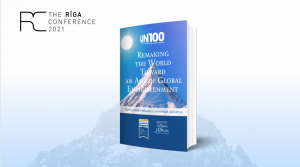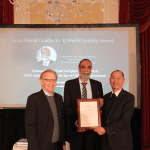February 12, 2023
United Nations Centennial Initiative and United Nations Day October 24th
Ramu Damodaran, the first Chief of United Nations Academic Impact (2010-2021), Co-Chair of the United Nations Centennial Initiative
In a phrase later paraphrased by, and hence often misattributed to, Dag Hammarskjold, Henry Cabot Lodge said of the then new United Nations that it would not “bring us to heaven, but might save us from hell.” As we observe the organization’s 76th anniversary on October 24, perceptions of both hell and heaven have become more proximate, the impact of the pandemic, or personal escape from it, a measuring rod, shaping also the ecumenical “Our Common Agenda” authored by UN Secretary-General Antonio Guterres last month as a moral, as much as political, compass for our common future.
Drawing upon rich sources, including a global conversation launched in 2020 that aggregated responses from 1.5 million people, the report builds upon Guterres’s determination that the 75th anniversary of the United Nations be opportunity to shape the future rather than celebrate the past, an idea that informed the Boston Global Forum’s own United Nations Centennial Initiative, looking at how the world would be in 2045, the moment the Organization reached a hundred years. Central to both the “Common Agenda” and our effort is the imperative of a new social contract, one Guterres defines as “between governments and their people and within societies so as to rebuild trust and embrace a comprehensive vision of human rights”, and one which we, in the specific context of our age of artificial intelligence (AI), see based upon “dialogue, tolerance, learning and understanding on key principles and practices for an agreement among members of society for shared social benefit.”
We see the shape of such agreement leading to the United Nations extending international human rights standards to AI (contributing to the “comprehensive vision” Guterres suggests), adopting a convention on the use of AI and establishing a specialized UN agency on AI. We have at least two precedents to draw upon, including the very first resolution adopted by the United Nations General Assembly, Resolution 1/1 of January 1946.
The four months between the signing of the UN Charter by its original members, on June 26,1945, and the formal launch of the Organization, on October 24, were punctuated by an event unforeseen when the Charter was drafted, the use of atomic weapons in August. That inspired the resolution “to deal with the problems raised by the discovery of atomic energy” and its creation of the UN Atomic Energy Commission with an objective to use atomic energy only for peaceful purposes. While there were certainly infirmities and evasions in the resolution, including the placement of the Commission under the authority of the Security Council rather than General Assembly, and its dissolution within a few years, it did set the pace for the International Atomic Energy Agency to emerge and, more immediately, the Treaty on the Prohibition of Nuclear Weapons which entered into force for its signatories in February this year.
A second precedent is the Organization for the Prohibition of Chemical Weapons (OPCW), charged with the implementation of the Chemical Weapons Convention with its unique provision for on-site inspections of operational chemical weapons destruction facilities as well as “challenge” inspections of use or production of chemical weapons alleged, with provision of verifiable proof, by one or more States against another. Worth noting is that although it has a working relationship with the United Nations, OPCW is not itself a UN body.
Both a Social Contract for the AI age and an alliance or compact for digital governance can be fashioned by nations within the forums of the United Nations or outside, as the precedents of IAEA and OPCW show. Our preference, given the leadership of the Secretary-General, would be the former; it is odd that, in 2021, matters relating to AI are dispersed among UN entities as disparate as its Conference on Disarmament, its Inter-regional Crime and Justice Research Institute and the International Telecommunications Union. Sound and swift multilateral action can inspire creative academic, scientific and civil society endeavors, including the emergence of an AI “World Society” (AIWS) and of AIWS Cities, urban centers for innovation and reflection, both of which we suggest in our own report.
As we repair our world and our lives, the moment is opportune. As Derek Walcott, the Nobel literature laureate who taught at Boston University for a number of years reminded us, when you “break a vase, the love that reassembles the fragments is stronger than that love which took its symmetry for granted when it was whole.” Let’s seize that strength.







